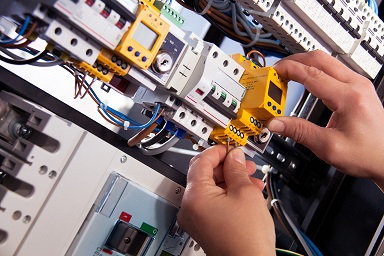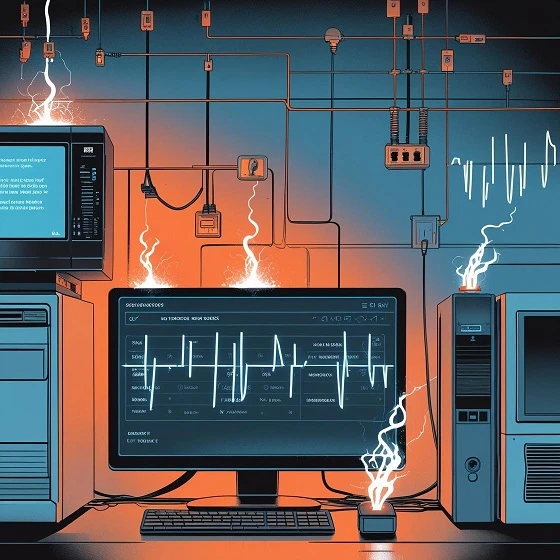Homeowners in Thousand Oaks, CA are using more electricity than ever before. From EV chargers and smart home systems to heavy kitchen appliances, the demand on household circuits has skyrocketed. Unfortunately, many homes still rely on older wiring or outdated breaker panels that simply weren’t designed for today’s power needs. According to the NFPA, overloaded circuits are the leading cause of residential electrical fires in the U.S., responsible for nearly 51,000 home fires every year, with California alone accounting for 8% of those incidents. That means what may seem like a simple breaker trip can actually be an early warning sign of a much bigger problem.
The good news is that overloaded circuits can be prevented with the right approach. By upgrading breaker panels, installing dedicated circuits for high-powered appliances, and scheduling professional inspections, homeowners can significantly reduce their risks. A licensed electrician can diagnose hidden issues, balance electrical loads, and bring older systems up to modern safety standards—all while protecting both your property and your family.
In this blog, we’ll break down everything you need to know about overloaded circuits in residential homes. From the warning signs and dangers to prevention strategies and professional solutions, this guide will help you keep your Thousand Oaks home safe and efficient.

What Is an Overloaded Circuit and How Does It Happen?
A circuit overload happens when the current flow exceeds what the circuit and breaker switch can handle.
Each breaker has a capacity limit, usually between 15–20 amps in residential homes.
When demand passes that limit, wires heat up, insulation weakens, and fire hazards appear.
How Overloading Occurs
Circuit overloads usually occur when too many devices plug into one outlet or line.
Picture a kitchen outlet powering a microwave, refrigerator, and dishwasher at the same time.
Older wiring systems in Thousand Oaks homes often struggle with today’s load capacities.
Even power strips and extension cords can create hidden stress on your electrical system.
Signs of Circuit Overload
Your home often gives warning signs before a major electrical issue occurs.
Look for:
- Lights dimming or losing brightness when appliances turn on
- Warm outlets, buzzing sounds, or discolored switches
- Breaker panel tripping frequently under normal use
- Burning smells or sparks near outlets or wires
If you notice more than one sign, your circuits may already be at risk.
What Are the Dangers of Overloaded Circuits?

Risk of Fires from Overloaded Circuits
Overloaded circuits are the leading cause of residential electrical fires in the U.S.
The NFPA reports that they cause nearly 51,000 home fires annually, leading to tragic losses.
In California, overloaded circuits account for 8% of nationwide electrical fire incidents.
Behind walls, overheated wires can ignite without warning, turning small problems into full disasters.
Electrical Damage to Household Devices
Unstable power flow from stressed circuits harms everything from gaming PCs to washers and dryers.
Voltage fluctuations can fry sensitive components, shorten appliance life, and corrupt data on computers.
Replacing damaged household appliances or a home entertainment setup can cost thousands.
Even small items like space heaters or freezers fail when circuits exceed safe limits.
Impact on the Breaker Panel
Your breaker panel is designed to trip and cut off power during overloads.
But constant tripping wears down breakers and weakens the entire electrical system.
The NEC reports breaker tripping is increasing 10% annually as homes add more devices.
Older homes in Thousand Oaks are 2–3 times more likely to face overloads due to outdated panels.
How Do Overloaded Circuits Affect Your Home’s Electrical System?
Effects on Circuit Breakers and Electrical Panels
Your circuit breakers are designed to protect your home by tripping when demand exceeds safe limits.
When overloads happen often, breakers wear down and may eventually fail to trip correctly.
A weakened breaker panel puts your home at greater risk of fire or system damage.
I’ve seen homes in Thousand Oaks where repeated overloads forced a full panel upgrade.
Long-Term Impact on Wiring and System Efficiency
Overloaded circuits don’t just stress breakers—they slowly damage your home’s wires.
Excess heat breaks down insulation, exposing copper and raising shock risks for homeowners.
Over time, this lowers your system efficiency and can even increase your energy bill.
If your wiring keeps struggling, you may face costly rewiring projects to restore safety.
What Are the Common Causes of Circuit Overload in Residential Homes?
Too Many Appliances on One Circuit
Running several high-demand appliances on the same circuit is a common mistake.
Kitchens, garages, and home offices are frequent problem spots because of heavy electrical demand.
Microwaves, refrigerators, and dishwashers should each have dedicated circuits to prevent overload.
Without separation, your current flow exceeds capacity and triggers tripping breakers.
Use of Power Strips and Extension Cords
Power strips and extension cords seem convenient but often create hidden electrical hazards.
Daisy-chaining strips adds more demand than the outlet and wiring were designed to handle.
This pressure on the circuit increases the chance of overheating, sparks, or even fires.
While surge protectors add some safety, they don’t fix the problem of excess load.
Outdated Electrical Systems in Older Homes
Older homes in Thousand Oaks are 2–3 times more likely to experience circuit overload.
Many were built before modern appliances, EV chargers, and home entertainment setups became common.
Outdated panels and wiring lack the capacity to handle today’s energy needs.
If your home still has an old breaker switch or fuse box, it’s time for an upgrade.
How Can You Prevent Circuit Overload in Your Home?
Understanding Your Circuit’s Capacity
Every circuit breaker has a specific capacity, usually 15 to 20 amps in most homes.
You should know which appliances connect to each breaker in your panel.
If the current flow exceeds this limit, the breaker will trip to prevent overheating.
Scheduling an inspection with a licensed electrician in Thousand Oaks can confirm safe load capacities.
Installing Dedicated Circuits for High-Powered Appliances
Large appliances like dryers, refrigerators, dishwashers, and EV chargers should have their own circuits.
Dedicated lines reduce the risk of overload and protect other devices from sudden power surges.
I’ve upgraded many older homes where a single line powered both a freezer and washing machine.
Once dedicated circuits were installed, breaker trips stopped, and the home ran more efficiently.
Avoiding Overloaded Power Strips and Extension Cords
Power strips and extension cords are temporary fixes, not long-term electrical solutions.
Plugging multiple devices into one outlet stretches the system beyond safe limits.
Even with surge protectors, you’re still overloading the wiring inside your walls.
Instead, add outlets or circuits where needed and protect your home from fire hazards.
What Are the Warning Signs of an Overloaded Circuit?
Tripped Circuit Breakers
A tripped breaker is your home’s way of saying the circuit is carrying too much demand.
Occasional trips aren’t unusual, but repeated trips signal deeper problems with your system.
If your breaker panel trips more than once a week, it’s time for professional troubleshooting.
Flickering or Dimming Lights
Lights dimming when appliances turn on is a classic sign of circuit overload.
This means your wiring can’t deliver steady electricity across all devices at once.
It’s not just an inconvenience—unstable power can damage sensitive household appliances.
Burning Smells Near Outlets
A faint burning smell near outlets or switches is a serious red flag.
Overheated wires or failing insulation may already be creating a fire hazard inside the wall.
If you notice burning odors, shut off power at the breaker panel and call an electrician immediately.
How Do You Troubleshoot an Overloaded Circuit?
Step-by-Step Guide to Troubleshooting Overloaded Circuits
Start by identifying which breaker tripped in your panel and what appliances are connected.
Unplug all devices on that circuit, then reset the breaker to restore power.
Plug devices back in one at a time to see which one triggers the overload.
If too many items are running at once, redistribute them to other circuits in your home.
You should also check outlets and switches for heat, buzzing, or scorch marks.
These signs show that wiring may already be stressed beyond safe limits.
When to Call an Electrician for Help
DIY troubleshooting only goes so far, especially if problems keep happening.
If you notice repeated breaker trips, flickering lights, or burning smells, call a professional.
A licensed electrician in Thousand Oaks can test circuit loads, upgrade panels, and rewire safely.
In many homes I’ve serviced, residents ignored breaker trips until hidden wiring damage caused major repairs.
Catching the issue early always saves money and prevents dangerous fire hazards.
What Are the Best Practices for Electrical Safety in Homes?
Regular Inspection and Maintenance of Wiring
Your home’s wiring should be inspected every few years, especially in older houses.
Loose connections, worn insulation, and outdated systems are common causes of electrical fires.
Regular checkups ensure your electrical system stays efficient and code-compliant.
Upgrading Electrical Panels to Meet Modern Demands
Today’s homes use far more electricity than those built 30 years ago.
Older panels may not handle modern loads like EV chargers, home theaters, or smart systems.
Upgrading your panel keeps your circuits balanced and prevents overloads before they happen.
At Electrician Thousand Oaks CA, we install and replace breaker panels tailored to your needs.
Installing Surge Protectors for Added Safety
Whole-home surge protection shields your appliances and wiring from sudden voltage spikes.
These surges can come from lightning, grid issues, or even large appliances cycling on.
Installing a surge protector at the breaker panel is one of the smartest safety investments.
Why Should You Hire a Professional Electrician for Overload Issues?
The Importance of Professional Diagnosis and Repair
Overloaded circuits are more than an inconvenience—they’re a serious safety risk.
A licensed electrician can properly assess your wiring, breakers, and panel for hidden hazards.
Attempting DIY fixes may overlook stressed wires or faulty components, increasing fire risk.
Professional diagnosis ensures your home electrical system meets modern safety standards.
Benefits of Hiring a Licensed Electrician for Circuit Repairs
Hiring an expert guarantees work is done safely and according to code.
Professionals can install dedicated circuits, upgrade panels, and redistribute loads efficiently.
This reduces breaker trips, prevents appliance damage, and protects your family and property.
At Electrician Thousand Oaks CA, we handle everything from inspections to 24/7 emergency repairs.
Get Your Electrical System Checked Today – Call Electrician Thousand Oaks, CA
Professional Circuit Overload Solutions
We provide comprehensive solutions for residential, commercial, and industrial electrical systems.
Our services include panel upgrades, troubleshooting, EV charger installation, and safety inspections.
We help prevent overloads, fires, and electrical damage before they become costly problems.
Why Choose Us? Expert Local Electricians for Safety and Efficiency
With over 10 years of experience, owner Charles J Hutchinson leads a team of licensed professionals.
We serve Thousand Oaks, Newbury Park, Westlake Village, Oak Park, Agoura Hills, Moorpark, and Simi Valley.
Our goal is reliable, safe, and efficient electrical systems for every home and business.
Schedule Your Electrical Inspection Today!
Don’t wait until a circuit overload turns into a fire or appliance failure.
Call Electrician Thousand Oaks CA at (805) 309-5414 or email [email protected].
Schedule a full electrical inspection or panel evaluation to keep your home safe and efficient.
